History of the House / 1844 to 1864 - Cornelius Egan
Previous / Next: 1864 to 1878 - Bunbury McClintock
Earlscliffe residents 1844 to 1864
The first person we believe owned and possibly lived in Earlscliffe was Alderman Cornelius Egan.
Cornelius Egan
Family history
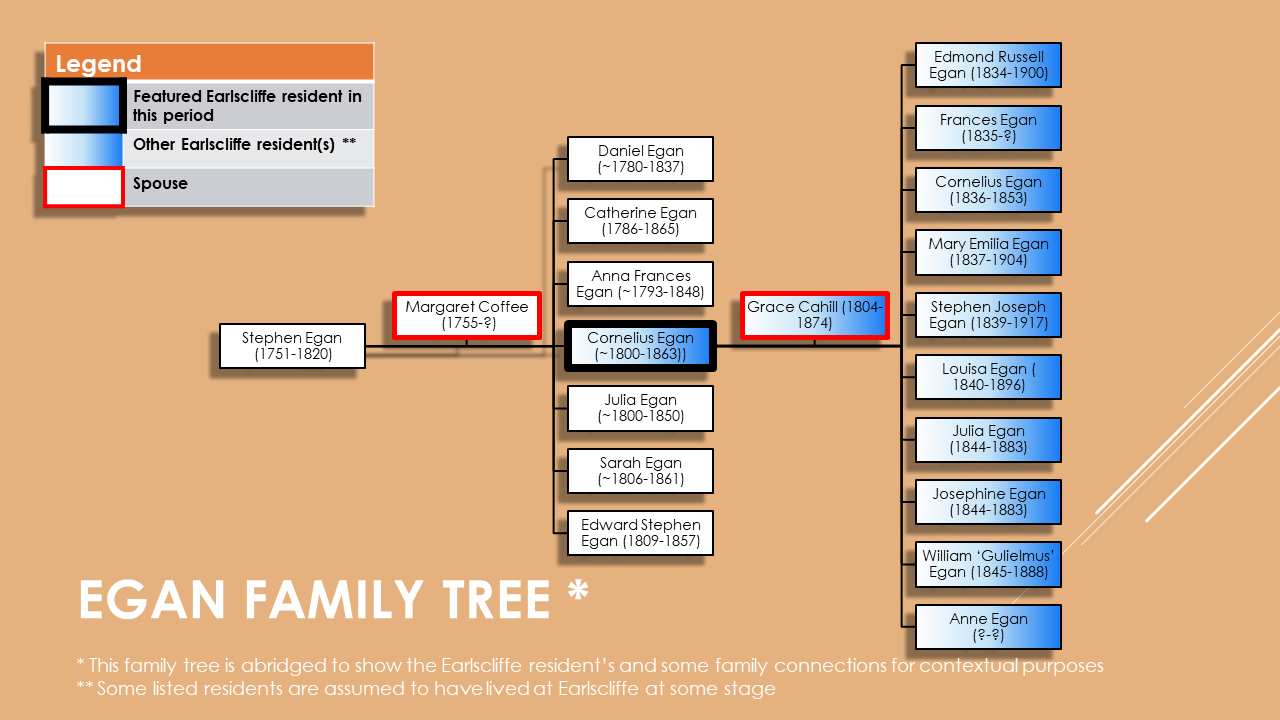
Cornelius Egan was born about 1800. His father was Stephen Egan, a brewer from Roscrea. Stephen Egan had married Margaret Coffee around 1776 and they had eight children.
Stephen had a brewery and distillery in Roscrea which was later managed by two of his sons, Daniel and Stephen. Cornelius grew up with the distilling industry and its associated businesses which probably influenced his choice of career in his early years.
Brewing conspiracies!
In the town of Roscrea there were two brewers, the Catholic distillers, Egan and and the rival wealthy Protestant distillers, Birch. [2]
In 1816, an incident occurred in Roscrea whereby the local Protestant
curate and magistrate, Rev. John Hamilton, accused the Egans of conspiracy
to murder the Protestant gentry of the neighbourhood
by going
past his house and firing shots at him whilst he was sat in his window
saying his prayers. Attempted murder in those days was a capital offence.
After a lengthy trial that eventually fell apart with contradicting statements, the whole incident was revealed as an attempt by the rival protestant brewer to put the Egan family out of business and the case was thrown out of court. [1] [2] [3] [4]
Cornelius early years
By 1824, Cornelius Egan was a Corn Merchant working in Ringsend in Dublin 4. Along with his brother, Stephen Egan, Cornelius joined the National Political Union of Ireland in 1831. This body had been set up to serve as a pressure group for parliamentary reform. [5]
On the 29 June 1832, Cornelius married Grace Cahill in Booterstown in Dublin [6] and they went on to have 10 children [7]
By 1834 they were living in Kingstown (now Dún Laoghaire) and in 1841 Cornelius became Alderman of Dublin City Council. [8]
By 1843, Egan was living and working on 27, Bachelors Walk in the centre of Dublin and by 1844 owned a wholesale merchant company (Cornelius Egan & Co) selling hops, seed, malt and corn. [8]
The building of Emily Cottage / Emily House / Earlscliffe
We believe that the house which we now call Earlscliffe was built around 1845, possibly by Cornelius Egan, although there is an outside possibility it could have been built by William McDougall (to be confirmed).
We assume that Earlscliffe was built to rent, primarily as a summer residence, as the coming of the train to Howth, along with the improved roads meant that Howth was becoming a popular summer retreat for the nobility that lived in the centre of Dublin.
Although the dates are a little uncertain, we do know that Egan owned the land in 1848 under a 99-year lease of 1847 from the Earl of Howth. [9] [10] Griffith's Valuation dated 1848 (shown below) indicates that Egan owned the lands marked 2a and 2b. We don't have a map from 1848, but we do have one from 1880 which shows the areas 2a and 2b, with Earlscliffe on the land marked 2b (see table and map below).
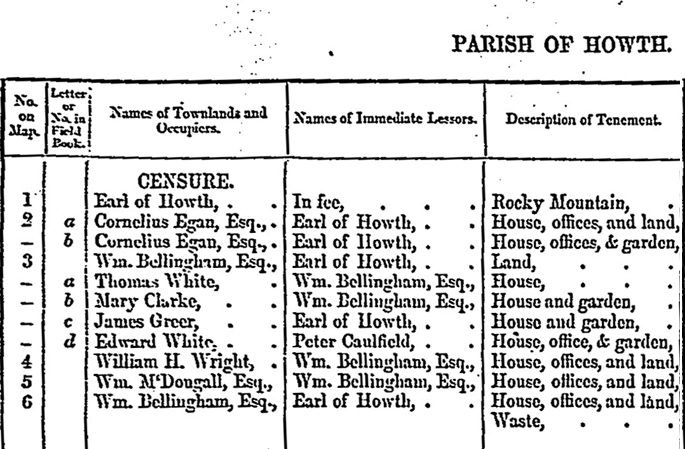
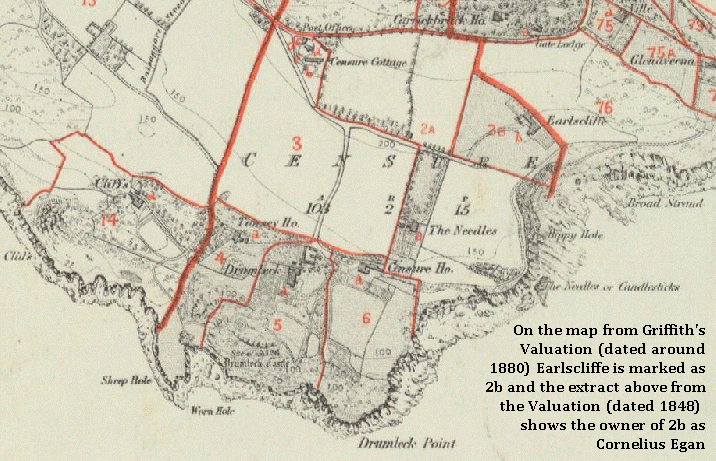
Evidence around the origins of Earlscliffe
Our evidence to date about the origins of Earlscliffe start with a number of houses
that were regularly up for rent in
the Sutton and Howth area from around 1846, all managed through 27,
Bachelor's Walk, Dublin (the property of Cornelius Egan). The one
that we believe that is now called Earlscliffe was advertised in 1846 as being
built last summer
which would date Earlscliffe as 1845.[17]
Each of the rental properties were re-advertised regularly over the next fifteen years. In the early years, the property we think is Earlscliffe was not named. However, the descriptions of the property and location make it almost certain to be Earlscliffe.
In 1853, the property was described as a detached large Cottage
.[18]
By 1860, the property was named as Emily Cottage
and by 1861 was described as a large superior Detached
Cottage-House
.[19][20]
By 1862, the property was advertised as Emily House
[21] and
this was the property that the first known resident, William Bunbury
McClintock, initially rented out. Correspondence from McClintock in
1863 stated the property name as Earlscliffe (possibly
after the Earl of Howth who leased out the land).
I am still researching into Emily House and if Emily House was actually what Earlscliffe was originally called. For more details of my research so far see the following:
We don't know much more about Egan and Earlscliffe, but we do know that there were legal dealings with Egan and his executors and William McDougall of Drumleck, Howth (see map above).[11]
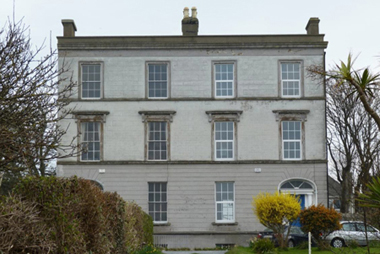
Egan's other properties
Egan owned and was landlord for many properties around Dublin and other areas, and owned a number of properties in Howth which, we assume, he either lived in or rented out. According to Thom's Irish Almanac & Official Directory, in 1849, Egan owned Devonshire Terrace in Strand Road, Sutton (now called Beachfield House) [12] and in 1852 he also owned St Lawrence House in Howth village. [13]
We assume that, when Egan lived in Howth, it was only during the summer months, and that during the winter he lived at his main premises at 27 Bachelor's Walk in Dublin. [7]
On 26 Oct 1853, Egan's son, also called Cornelius, died tragically in Howth after his gun accidentally exploded whilst shooting. He is buried in St Mary's in Howth [14]
Alderman Egan, at this stage, was living in St Lawrence House during the summer and, we presume, if he owned Earlscliffe, he had rented the property out.
Cornelius Egan died on 2nd July 1863 in St Lawrence House in Howth and is buried at St. Fintan's cemetery in Sutton. [15] [16] He was survived by his wife, Grace, who subsequently moved to Antwerp in Belgium in 1871 and died on the 27th Aug 1874. [7]
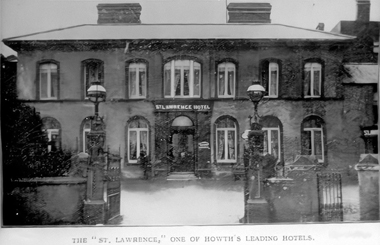
St. Lawrence House was later converted into a hotel, which closed in the summer of 2000 and is now an apartment complex.
In terms of Earlscliffe, we know that Egan owned the land up to at least 1850 [10]. However, we assume that Egan's death in 1863 prompted the sale of land, Earlscliffe (and probably his other properties).
Further information
• •
List of Earlscliffe Residents
References
- [1] See https://sorp.nationalarchives.ie/search/index.php?browse=true&category=27&subcategory=188&offset=980&browseresults=true
- [2] As described in Chaptehttps://sorp.nationalarchives.ie/search/index.php?browse=true&category=27&subcategory=188&offset=980&browseresults=true
- [2] As described in Chapter 8: 'The Zeal of a pacificator' in Daunt, William J. O'Neill, "Eighty-five years of Irish history, 1800-1885", Published 1888 London : Ward and Downey, pp.81-89. On page 105 there is an inscrption that that states "My account of the transactions described in this chapter is dervied from a manuscript narrative lent to me by one of the Egan family, Alderman Egan of Dublin..." See https://archive.org/details/eightyfiveyearso00daunrich/page/74/mode/2up?view=theater&q=egan
- [3] "Horrible Conspiracy Against the Lives of Irish Catholics" in The Orthodox journal and Catholic monthly intelligencer ed. W.E. Andrews The Orthodox Journal and Catholic Monthly Intelligencer - Google Books
- [4] See https://offalyhistoryblog.wordpress.com/2018/05/05/the-other-egans-from-birr-and-roscrea-by-dermot-mcauley/
- [5] See https://en.wikipedia.org/wiki/National_Political_Union_(England))
- [6] As quoted on Ancestry.com here: http://person.ancestry.co.uk/tree/65874258/person/46146369365/facts. Marriage details can be seen here https://registers.nli.ie/registers/vtls000633702#page/19/mode/1up
- [7] Slater's 1870 commercial directory as quoted on Ancestry.com here: http://person.ancestry.co.uk/tree/65874258/person/46146369365/facts and seen in http://www.willcalendars.nationalarchives.ie/reels/cwa/005014884/005014884_00430.pdf
- [8] Slater's Commercial Directory of Ireland 1846, pg 82 http://ww.failteromhat.com/slater/0264.pdf
- [9] A sale notice for Earlscliffe in the Irish Times July 6 1895 mentions that it is "held as to part for 143 years from 1st November 1844, under a lease dated 15th December 1847, and a reversionary lease dated 1st May 1895..."
- [10] Griffith's Valuation 1848 and 1850 show that Egan occupied houses and land marked as 2a and 2b on the map, where 2b is shown as Earlscliffe House and lands. (On the maps, the numbers represent a lot number. Capital letters after the subdivision number (e.g. ‘2A, B ,C’) are used to label subdivisions within a lot and indicate separate parcels of property in the townland held by the same individual. Lower case letters indicate properties).
- [11] From the Lisnavagh Archives (G 8/12). As relayed to me by Turtle Bunbury in July 2009. As an aside, a later owner of Earlscliffe, John Pentland Mahaffy, married the daughter of William McDougall in 1865.
- [12] https://consult.fingal.ie/en/system/files/materials/4389/Howth-Mal%20-%20Building%20Structure%20-%20Prop%20Add.pdf retrieved on 21-Sep-2021
- [13] Thom's Irish Almanac & Official Directory, as listed in "Extracts From Various Trade Directories 1834 To 1910" https://freepages.rootsweb.com/~chrisu/genealogy/howth/howth_dir2.htm retrieved 23-Jul-2023.
- [14] As reported in the Worcester Journal, 5th November 1853.
- [15] Thom's Irish Almanac & Official Directory 1852, to 1864.
- [16] Calendars of Wills and Administrations, 1863 http://www.willcalendars.nationalarchives.ie/reels/cwa/005014884/005014884_00430.pdf
- [17] Advert placed in Saunders's News Letter on 4th June 1846.
- [18] Advert placed in Saunders's News Letter on 25th May 1853.
- [19] Advert placed in Saunders's News Letter on 31st May 1860.
- [20] Advert placed in Saunders's News Letter on 2nd July 1861.
- [21] Advert placed in Saunders's News
Letter on 30th Apr 1862.
This page was last updated on 12-Sep-2023 .
